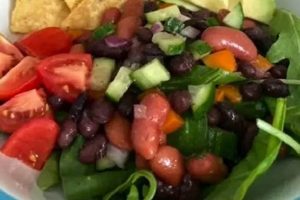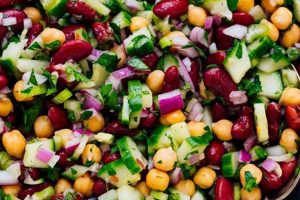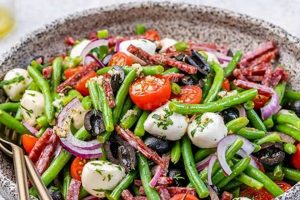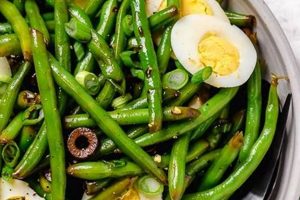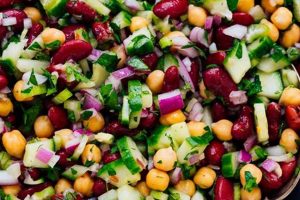Simple, quick-to-prepare salads featuring beans as the primary ingredient offer a nutritious and versatile meal option. These dishes often combine legumes with various vegetables, herbs, and a flavorful dressing. For instance, a classic variation might include canned kidney beans, black beans, corn, diced red onion, and a vinaigrette.
Such salads are valued for their nutritional density, providing protein, fiber, and essential vitamins and minerals. They can be adapted to suit diverse dietary needs and preferences, making them an excellent choice for vegetarians, vegans, or those seeking gluten-free options. Historically, bean salads have emerged as a practical and affordable way to incorporate legumes into diets across cultures, evolving alongside agricultural practices and culinary traditions.
This article will delve into a range of straightforward and flavorful bean salad preparations, exploring different ingredient combinations, dressing options, and tips for successful results. From classic combinations to innovative twists, readers will discover a variety of inspiring recipes suitable for everyday meals, potlucks, or picnics.
Tips for Creating Delicious and Easy Bean Salads
Achieving optimal flavor and texture in bean salads requires attention to a few key details. These tips offer guidance for creating satisfying and effortless dishes.
Tip 1: Rinse Canned Beans Thoroughly: Rinsing canned beans under cold water removes excess starch and sodium, resulting in a cleaner flavor and improved texture.
Tip 2: Embrace Variety: Combine different bean types for a more complex flavor profile and visual appeal. Consider using kidney beans, black beans, chickpeas, or cannellini beans.
Tip 3: Add Fresh Herbs: Fresh herbs like parsley, cilantro, or mint elevate the flavor profile, adding brightness and complexity.
Tip 4: Consider Textural Contrast: Incorporate crunchy elements such as diced bell peppers, red onion, or celery for textural contrast.
Tip 5: Balance Flavors with Acidity: A vibrant vinaigrette or a squeeze of lemon or lime juice balances the richness of the beans and adds a refreshing tang.
Tip 6: Marinate for Enhanced Flavor: Allowing the salad to marinate in the dressing for at least 30 minutes, or even overnight, allows the flavors to meld and deepen.
Tip 7: Don’t Overdress: Start with a smaller amount of dressing and add more as needed to prevent a soggy salad.
By following these tips, one can ensure a successful and flavorful bean salad experience. These simple steps contribute significantly to the overall quality and enjoyment of the dish.
With these insights in mind, let us now explore some specific recipe variations that demonstrate the versatility and appeal of bean salads.
1. Simple Preparation
Simple preparation is a defining characteristic of easy bean salad recipes. The inherent convenience stems primarily from the utilization of canned beans, eliminating the need for lengthy soaking and cooking processes. This factor significantly reduces preparation time, making these salads an attractive option for quick meals or situations where time is limited. For instance, a classic three-bean salad can be assembled in minutes by simply combining canned kidney beans, pinto beans, and green beans with a pre-made or quickly whisked vinaigrette.
The ease of preparation extends beyond the use of canned beans. Chopping vegetables, such as onions, bell peppers, or celery, constitutes the majority of the remaining active preparation time. Furthermore, many recipes require no cooking at all, relying on the natural flavors of the ingredients and the complementary dressing. This characteristic contributes to their popularity, particularly during warmer months when minimal cooking is desired. The ability to combine readily available ingredients with minimal effort makes these salads a practical and appealing choice for various occasions, from everyday lunches to potlucks.
In conclusion, the simplicity of preparation is crucial to the appeal and practicality of easy bean salad recipes. The reliance on canned beans and readily available ingredients minimizes active cooking time, making these salads an efficient and convenient meal option. This characteristic, combined with the nutritional value and versatility of bean salads, solidifies their place as a staple in many kitchens.
2. Versatile Ingredients
Versatility defines the ingredient profile of easy bean salads. This adaptability stems from the inherent compatibility of beans with a wide array of other components. Beans serve as a neutral base, readily absorbing and complementing flavors from diverse vegetables, herbs, spices, and dressings. This characteristic allows for extensive customization based on individual preferences, dietary needs, and seasonal availability. For example, a summer bean salad might incorporate fresh corn, tomatoes, and basil, while an autumn version could feature roasted sweet potatoes, cranberries, and pecans. This inherent flexibility makes bean salads an ideal platform for culinary creativity and ensures their suitability for diverse palates and occasions.
The versatility of bean salad ingredients extends beyond flavor profiles. Textural variety can be achieved by incorporating crunchy elements like bell peppers, celery, or nuts, alongside the softer texture of the beans. This contrast enhances the sensory experience and adds complexity to the dish. Furthermore, ingredient choices can be tailored to accommodate dietary restrictions. Gluten-free versions can be easily achieved by selecting appropriate dressings and avoiding gluten-containing grains. Vegan options are readily available by omitting cheese or other animal products. This adaptability makes bean salads an inclusive dish suitable for a broad range of dietary needs.
In conclusion, the versatility of ingredients in easy bean salads is a defining characteristic that contributes significantly to their appeal and practicality. The ability to incorporate diverse flavors, textures, and dietary accommodations makes these salads an adaptable and inclusive dish suitable for various occasions and individual preferences. Understanding this adaptability empowers individuals to create personalized versions, maximizing both flavor and nutritional value while aligning with specific dietary needs and culinary preferences.
3. Nutritious Legumes
The nutritional value of legumes plays a crucial role in the appeal of easy bean salad recipes. These recipes offer a convenient and palatable way to incorporate the numerous health benefits of legumes into one’s diet. Understanding the specific nutritional contributions of these ingredients provides a deeper appreciation for their significance in a balanced and healthy eating pattern.
- Protein Powerhouse:
Legumes are a significant source of plant-based protein, essential for building and repairing tissues, supporting immune function, and maintaining healthy hair and nails. A single cup of cooked beans can provide up to 15 grams of protein. In bean salads, this protein content contributes to satiety, making them a satisfying meal option. This is particularly beneficial for vegetarian and vegan diets, where legumes often serve as a primary protein source.
- Fiber-Rich Composition:
Legumes are rich in dietary fiber, both soluble and insoluble. Soluble fiber helps regulate blood sugar levels and lowers cholesterol, while insoluble fiber promotes digestive health and prevents constipation. The high fiber content in bean salads contributes to feelings of fullness, aids in weight management, and supports overall digestive well-being.
- Micronutrient Density:
Legumes offer a wealth of essential micronutrients, including iron, folate, magnesium, potassium, and zinc. Iron is crucial for oxygen transport, folate supports cell growth and development, magnesium contributes to bone health, potassium regulates blood pressure, and zinc bolsters the immune system. Bean salads provide a readily accessible way to incorporate these vital micronutrients into the diet, contributing to overall health and well-being.
- Low Glycemic Index:
Legumes generally have a low glycemic index (GI), meaning they cause a slower rise in blood sugar levels compared to high-GI foods. This characteristic makes them a suitable choice for individuals managing blood sugar levels, such as those with diabetes. The low GI of bean salads contributes to stable energy levels and helps prevent blood sugar spikes.
The combination of protein, fiber, micronutrients, and a low glycemic index makes legumes a nutritional powerhouse. Easy bean salad recipes capitalize on these benefits, providing a convenient and flavorful way to incorporate these valuable nutrients into the diet. The nutritional density of these salads contributes to overall health and well-being, making them a smart and satisfying meal choice.
4. Flavorful Dressings
Flavorful dressings play a pivotal role in elevating easy bean salad recipes from simple to exceptional. The inherent neutrality of beans, while offering versatility, necessitates a compelling dressing to impart depth and complexity. Dressings provide the crucial bridge between individual ingredients, unifying disparate flavors and textures into a cohesive and palatable whole. The right dressing can transform a basic bean salad into a culinary delight, enhancing the overall sensory experience.
Consider the impact of a vibrant citrus vinaigrette on a black bean and corn salad. The acidity of the citrus cuts through the richness of the beans, while the bright, tangy notes complement the sweetness of the corn. Alternatively, a creamy cilantro-lime dressing adds a refreshing herbaceous element to a kidney bean and avocado salad. These examples illustrate the transformative power of a well-chosen dressing, demonstrating how it can elevate the overall flavor profile and create a more satisfying culinary experience. The careful selection of a dressing, considering the specific ingredients and desired flavor outcome, is essential for maximizing the potential of any bean salad.
The practical significance of understanding the role of flavorful dressings in easy bean salad recipes lies in the ability to create customized flavor profiles tailored to individual preferences. By experimenting with different combinations of oils, vinegars, herbs, spices, and other flavoring agents, one can achieve a wide range of flavor profiles, from tangy and bright to rich and savory. Mastering the art of dressing preparation empowers individuals to transform simple ingredients into memorable dishes. Furthermore, the ability to create homemade dressings offers greater control over ingredients and nutritional content, aligning with health-conscious approaches to cooking. Ultimately, the thoughtful selection and preparation of flavorful dressings unlocks the full potential of easy bean salad recipes, transforming them into versatile and satisfying culinary creations.
5. Customizable Options
Customizability represents a significant advantage of easy bean salad recipes. This adaptability stems from the inherent neutrality of beans as a base ingredient, allowing them to harmonize with a wide array of flavors and textures. This characteristic makes bean salads exceptionally adaptable to individual preferences, dietary needs, and seasonal ingredient availability. One can readily adjust a basic recipe by incorporating preferred vegetables, such as bell peppers, cucumbers, or corn. Customization extends to protein additions; grilled chicken or tofu can easily be integrated for a more substantial meal. Dietary restrictions can be accommodated through ingredient swaps; for example, using quinoa instead of couscous ensures gluten-free compatibility.
Consider a scenario where a standard three-bean salad recipe serves as a foundation. One individual might prefer a Mediterranean twist, incorporating Kalamata olives, feta cheese, and a lemon-herb vinaigrette. Another might opt for a Southwestern flair, adding corn, black beans, avocado, and a chipotle-lime dressing. These examples illustrate the practical application of customizability, demonstrating how a single base recipe can be adapted to create diverse flavor profiles. Furthermore, the ability to customize allows for efficient utilization of available ingredients, minimizing food waste and promoting economical meal planning. Seasonal variations can be readily incorporated, ensuring access to fresh, flavorful produce throughout the year.
In summary, the customizability inherent in easy bean salad recipes presents a significant benefit for both novice and experienced cooks. This adaptability empowers individuals to tailor recipes to specific preferences and dietary needs, maximizing both flavor and nutritional value. The practical implications of this customizability extend to efficient ingredient utilization, reduced food waste, and the ability to create diverse and satisfying meals aligned with seasonal availability and individual culinary preferences. Ultimately, this inherent flexibility contributes significantly to the enduring popularity and practicality of bean salads as a versatile culinary staple.
6. Budget-Friendly Meals
A strong correlation exists between budget-friendly meals and easy bean salad recipes. Legumes, the foundational ingredient, represent a cost-effective protein and fiber source compared to animal-based proteins or processed foods. Dried beans offer even greater savings, though they require pre-soaking and cooking. Canned beans, while slightly more expensive, provide unmatched convenience, making them a practical choice for time-constrained individuals. Supplemental ingredients, such as common vegetables like onions, carrots, and celery, contribute to affordability. These vegetables are often readily available and can be purchased in larger quantities to further reduce costs. A simple vinaigrette, utilizing pantry staples like oil and vinegar, completes the dish without adding significant expense.
Consider a household aiming to reduce grocery expenses. Replacing meat-centric meals with bean-based salads twice a week can lead to substantial savings over time. A simple black bean and corn salad, for instance, requires minimal ingredients and offers a complete protein source at a fraction of the cost of a steak or chicken-based meal. This substitution not only reduces grocery bills but also increases dietary fiber intake, contributing to better health outcomes. Furthermore, bean salads offer versatility in terms of portioning and leftovers. They can be prepared in larger batches for multiple meals, reducing overall cooking time and maximizing the value of purchased ingredients. This adaptability makes them an ideal choice for meal prepping or feeding larger families on a budget.
In conclusion, the affordability of easy bean salad recipes stems from the cost-effectiveness of legumes, the utilization of readily available vegetables, and the simplicity of dressing preparation. Incorporating these salads into meal planning offers a practical strategy for reducing food expenses without compromising nutritional value or flavor. This connection between budget-conscious cooking and the inherent affordability of bean salads establishes them as a valuable tool for individuals and families seeking economical and nutritious meal options. The versatility and adaptability of these recipes further enhance their value, allowing for creative ingredient utilization and customization to suit individual preferences and dietary needs while remaining budget-friendly.
7. Excellent Make-Ahead Dish
The “make-ahead” nature of easy bean salad recipes significantly contributes to their practicality and appeal. Preparing these salads in advance offers numerous advantages, ranging from simplified meal planning to enhanced flavor development. This characteristic aligns seamlessly with contemporary lifestyles, where time constraints often necessitate efficient and convenient meal solutions. Exploring the facets of this “make-ahead” advantage reveals its true value in the context of easy bean salad recipes.
- Time-Saving Convenience:
Preparing bean salads ahead of time reduces mealtime stress, particularly during busy weeks. This advance preparation allows for efficient allocation of time and resources. Imagine a scenario where a week’s worth of lunches is prepared on Sunday. A large batch of bean salad, stored in individual containers, provides grab-and-go convenience throughout the week, eliminating the need for daily meal preparation. This time-saving aspect proves invaluable for individuals juggling work, family, and other commitments.
- Enhanced Flavor Development:
The flavors of bean salads often intensify as they marinate in the dressing. Making the salad a day or two in advance allows the ingredients to meld, creating a more complex and nuanced flavor profile. This extended marination period allows the dressing to penetrate the beans and vegetables, resulting in a more harmonious and flavorful dish compared to a freshly prepared salad. This flavor enhancement is a significant benefit of the make-ahead approach.
- Ideal for Social Gatherings:
Bean salads are well-suited for potlucks, picnics, and other social gatherings due to their portability and make-ahead convenience. Transporting a pre-made bean salad eliminates on-site preparation, simplifying logistics and allowing hosts or guests to focus on other aspects of the event. This portability, combined with the ability to serve the salad at room temperature, makes it a practical and popular choice for various social occasions.
- Reduced Food Waste:
Making a large batch of bean salad allows for efficient utilization of ingredients, minimizing potential food waste. Leftovers can be readily incorporated into subsequent meals or repurposed in creative ways, such as wraps, sandwiches, or grain bowl toppings. This adaptability contributes to sustainable food practices and reduces household food waste, aligning with environmentally conscious approaches to meal planning.
In conclusion, the “make-ahead” characteristic of easy bean salad recipes significantly enhances their value and practicality. This advantage streamlines meal preparation, intensifies flavors, simplifies social gatherings, and promotes reduced food waste. These combined benefits contribute to the enduring appeal of bean salads as a versatile and convenient meal option for individuals and families seeking efficient and flavorful culinary solutions. From busy weeknight dinners to festive gatherings, the make-ahead nature of these recipes elevates their role beyond a simple side dish, establishing them as a valuable component of a well-rounded and practical culinary repertoire.
Frequently Asked Questions
This section addresses common inquiries regarding simple bean salad preparations, offering practical guidance and clarifying potential uncertainties.
Question 1: How long can bean salad be stored in the refrigerator?
Properly stored bean salad, refrigerated in an airtight container, typically remains safe for consumption for three to five days.
Question 2: Can dried beans be used instead of canned beans?
Dried beans are suitable substitutes for canned beans. However, they require pre-soaking and cooking before incorporation into a salad. Soaking overnight and then simmering until tender achieves optimal texture.
Question 3: What are suitable dressing alternatives for vinegar-based vinaigrettes?
Individuals sensitive to vinegar can substitute citrus juice, such as lemon or lime, or explore tahini-based dressings for alternative flavor profiles.
Question 4: How can the sodium content of bean salad be reduced?
Thoroughly rinsing canned beans under cold water significantly reduces sodium content. Using low-sodium or no-salt-added canned beans, coupled with homemade dressings, further minimizes sodium intake.
Question 5: Can bean salad be frozen?
Freezing bean salad is not generally recommended. Freezing alters the texture of the beans and vegetables, resulting in a less desirable consistency upon thawing. Fresh preparation is advisable for optimal quality.
Question 6: How can one prevent bean salad from becoming watery?
Adding the dressing shortly before serving helps prevent excess moisture. Ensuring vegetables are adequately dried before incorporation also minimizes water accumulation in the salad.
Understanding these common points of inquiry allows for successful and enjoyable bean salad preparation. Careful consideration of storage, ingredient selection, and dressing techniques contributes significantly to the overall quality and flavor of the final dish.
Further exploration of specific recipe variations and detailed instructions follows in the subsequent sections.
Conclusion
This exploration of easy bean salad recipes has highlighted their multifaceted benefits, ranging from nutritional value and budgetary advantages to culinary versatility and convenient preparation. The simplicity of combining legumes with readily available ingredients, coupled with the adaptability of flavor profiles through diverse dressings, positions these salads as a practical and appealing culinary option. The analysis of key aspects, including ingredient selection, dressing preparation, and storage considerations, provides a comprehensive understanding of the elements contributing to successful outcomes. Furthermore, addressing common inquiries offers practical guidance for both novice and experienced cooks seeking to maximize flavor and convenience.
The adaptability and inherent simplicity of easy bean salad recipes underscore their enduring relevance in contemporary culinary practices. These recipes offer a pathway to incorporating nutritious legumes into diets while accommodating diverse palates and dietary needs. Continued exploration of flavor combinations and creative adaptations promises to further enhance the versatility of these dishes, solidifying their place as a valuable and adaptable culinary staple.

